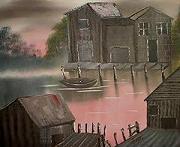|
From ARTLEX.com Art Dictionary
trompe l'oeil - A French term literally meaning "trick the eye." Sometimes called illusionism,
it's a style of painting which gives the appearance of three-dimensional, or photographic realism. It flourished from the
Renaissance onward. The discovery of linear perspective in fifteenth-century Italy and advancements in the science of optics
in the seventeenth-century Netherlands enabled artists to render object and spaces with eye-fooling exactitude. Both playful
and intellectually serious, trompe artists toy with spectators' seeing to raise questions about the nature of art and perception.
There is a story from ancient Greece that two painters were rivals in a contest: each would
try to make a picture that produced a more perfect illusion of the real world. One, named Zeuxis, painted a likeness of grapes
so natural that birds flew down to peck at them. Then his opponent, Parrhasius brought in his picture covered in a cloth.
Reaching out to lift the curtain, Zeuxis was stunned to discover he had lost the contest. What had appeared to be a cloth
was in reality his rival's painting.
Pere Borrell del Caso (Spanish, 19th century),Escaping Criticism (click on this link), 1874, oil on canvas, Banco de España, Madrid. In advance of art
criticism, this boy (the painting itself) appears to escape his (its) frame.

Studio Window 1200 mm x 1300 mm This is an oil painting on canvas painted for an exhibition. It is to be hung
on the wall without a frame, so that the edge of the stretcher becomes the edge of the architrave. The view is looking out
my studio window. Only the window catches were not painted from life .
|

